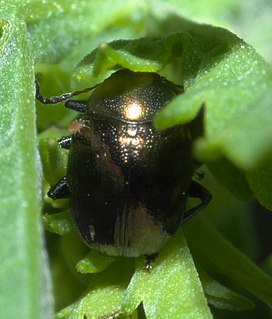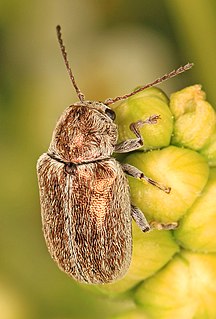
The Eumolpinae are a subfamily of the leaf beetles, or Chrysomelidae. It is one of the largest subfamilies of leaf beetles, including more than 500 genera and 7000 species. They are oval, and convex in form, and measure up to 10 mm in size. Typical coloration for this subfamily of beetles ranges from bright yellow to dark red. Many species are iridescent or brilliantly metallic blue or green in appearance.

Mahavisaurus is an extinct genus of rhytidosteid temnospondyl from the early Triassic period of Iraro, Madagascar. It is known from the holotype MNHN MAE 3037, a nearly complete skull, recovered from the Middle Sakamena Formation. This genus was named by J. P. Lehman in 1966, and the type species is Mahavisaurus dentatus.

Piabucus is a genus of freshwater tetras in the family Iguanodectidae. All three species are found in South America, largely the Amazon and its major tributaries. None of them are longer than half a foot long, with the largest reaching a maximum size of 12.9 cm (5.0 in), and they are slender, with relatively deep chests and long pectoral fins. Their scales are pale or silvery, with lateral lines that stand out.

Platycorynus is a genus of leaf beetles in the subfamily Eumolpinae. It is distributed in Africa and Asia.

Coccomyces dentatus is a species of fungus in the family Rhytismataceae. A widespread species, particularly in temperate areas, it colonizes the dead fallen leaves of vascular plants, particularly oak and chestnut. The fungus apothecia, which form in the epidermal layer of the leaf host, resemble dark hexagonal spots scattered on a multi-colored mosaic pattern bounded by thin black lines. When mature, the apothecia open by triangular flaps to release spores. The anamorph form of C. dentatus is Tricladiopsis flagelliformis. Lookalike species can be distinguished by the shape of the apothecia, or by microscopic characteristics.

The Spilopyrinae are a small subfamily of the leaf beetles, or Chrysomelidae. They occur in Australia, New Guinea, New Caledonia and Chile. They were formerly considered a tribe of the subfamily Eumolpinae. The group was elevated to subfamily rank by C. A. M. Reid in 2000. However, some authors have criticised this placement, preferring to retain them within the Eumolpinae.
Erythraella is a genus of leaf beetles in the subfamily Eumolpinae. It contains only one species, Erythraella bicuspidata, which is endemic to Socotra. The genus and species were described by Stefano Zoia in 2012. The genus name comes from the Latin name for the Arabian Sea, "mare Erythraeum". The species name, meaning "double pointed" in Latin, refers to the double point of the apex of the aedeagus. The genus is related to Lypesthes and Trichotheca.

Eumolpini is a tribe of leaf beetles in the subfamily Eumolpinae. It is the largest tribe in the subfamily, with approximately 170 genera found worldwide. Members of the tribe almost always have a longitudinal median groove on the pygidium, which possibly helps to keep the elytra locked at rest. They also generally have a subglabrous body, as well as appendiculate pretarsal claws.
Glyptoscelis juniperi is a species of leaf beetle. It is found in California in the United States.

Glyptoscelis is a genus of leaf beetles in the subfamily Eumolpinae. There are 38 species of Glyptoscelis described from North, Central and South America. There are also three species of Glyptoscelis known from the West Indies, though they are wrongly placed in the genus. In addition, a single species was described from Hunan, China in 2021.
Glyptoscelis albicans is a species of leaf beetle. It is found in the southeastern United States.
Tyrannomolpus is a genus of leaf beetles in the subfamily Eumolpinae. It is known only from Three Kings Islands, New Zealand. It contains only one species, Tyrannomolpus rex. T. rex is the largest chrysomelid beetle species endemic to New Zealand, measuring between 9.7 and 11.9 mm, and may be an example of island gigantism. It has a dark bronzy-green color with a metallic luster. Tyrannomolpus is closest to the genus Pilacolaspis from the mainland of New Zealand.
Lucignolo capensis is a species of leaf beetle endemic to South Africa, and the only member of the genus Lucignolo. It was first described by Édouard Lefèvre in 1890 as a species of the genus Trichostola. It was later found to be closely related to Odontionopa, and was placed in its own genus by Stefano Zoia in 2010.
Pseudolepis is a genus of leaf beetles in the subfamily Eumolpinae, found in Peninsular Malaysia in the vicinity of Kuala Lumpur. It contains only one species, Pseudolepis squamosa.
Obelistes is a genus of leaf beetles in the subfamily Eumolpinae. It is known from Africa.
Dictyneis is a genus of leaf beetles in the subfamily Eumolpinae. It is endemic to Chile. It is apterous.
Dorymolpus is a genus of leaf beetles in the subfamily Spilopyrinae. It contains only one species, Dorymolpus elizabethae. It is found only in Chile, in the Valdivian temperate rain forest of the Valdivia and Chiloé provinces.
Jansonius is a genus of leaf beetles in the subfamily Eumolpinae. It is found in Chile and Argentina. It was formerly placed in the tribe Adoxini, section Myochroites, but is now placed in Nodinini, section Metachromites.

Bromiini is a tribe of leaf beetles in the subfamily Eumolpinae. The tribe contains approximately 120 genera, which are found worldwide. They are generally thought to be an artificial group, often with a subcylindrical prothorax without lateral ridges and covered with setae or scales.








